Charts of the Week
Current economic trends from 29 November to 3 December 2021: gross domestic product, consumer prices, electricity consumption and turnover based on fiscal verification of invoices
The favourable developments in the Slovenian economy continued in the third quarter. As the containment measures were further eased and the economy and consumers adjusted to the changed conditions, private consumption in particular increased, while the growth of overall economic activity slowed down slightly. Especially in the export-oriented part of the economy, activities in the third quarter were already severely affected by supply chain disruptions and high commodity and energy prices. GDP grew by 1.3% quarter-on-quarter and 5% year-on-year, exceeding the pre-crisis Q4 2019 level. In the third quarter, this level was also exceeded by private consumption and according to data on fiscal verification of invoices, the relatively favourable trend in this segment continues in the last quarter of this year. Rising energy prices and supply chain disruptions also have a strong impact on inflation, which rose to 4.6% in November.
Gross domestic product, Q3 2021
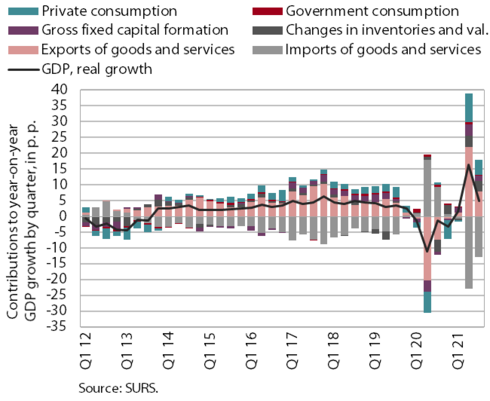
Economic growth continued in the third quarter. GDP increased by 1.3% compared to the second quarter and by 5% year-on-year. GDP thus exceeded the pre-crisis level reached in the last quarter of 2019. This development reflects the continued easing of the containment measures, as well as the adjustment of the economy and consumers to the changed conditions. This led to further strong growth in private consumption and related activities (retail trade, entertainment, sports, recreational and personal care services and accommodation and food service activities). Private consumption thus exceeded the level of the same period in 2019, and the aforementioned service activities, with the exception of trade, fell slightly short of the pre-epidemic level. Activities related to international trade (especially export-oriented manufacturing) were already affected by supply chain disruptions, which is why their growth slowed down. Manufacturing and exports and imports of goods, which were generally less affected by the containment measures, reached pre-crisis levels by the end of last year. Trade in services increased quarter-on-quarter, with exports of services still lagging behind pre-crisis levels, mainly due to lower travel activity. Year-on-year growth of gross fixed capital formation remained high and final government consumption was still higher year-on-year, with employment, spending on goods and services, and spending on pharmaceuticals and health services continuing to rise.
Consumer prices, November 2021
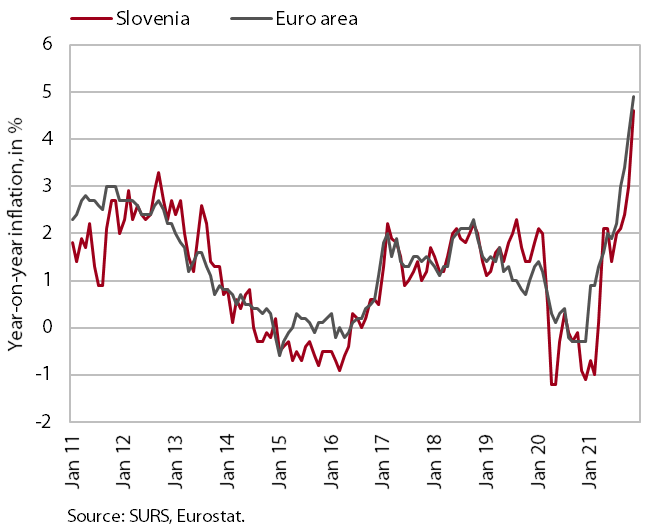
Year-on-year consumer price growth rose sharply again in November, to 4.6%. About half of the year-on-year increase was due to higher prices of energy, especially petroleum products and heat energy, which rose by more than 40% and 55% respectively. The higher year-on-year increase was also largely driven by the prices of semi-durable goods. The latter fluctuate strongly due to the different seasonal price movements in the clothing and footwear sector. After falling in the last two months, they rose by 4.3% year-on-year in November. In the face of higher commodity prices and supply chain bottlenecks, durable goods prices continued to rise year-on-year (5.8%), with car prices up 6.7%. Services price growth increased again somewhat year-on-year (1.5%). Prices in the restaurants and hotels group (6.2%) continued to rise, as did prices in the recreation and culture group, with a slightly stronger month-on-month increase in package holiday prices. The year-on-year increase in food prices also strengthened slightly (by about 1%).
Electricity consumption, November 2021
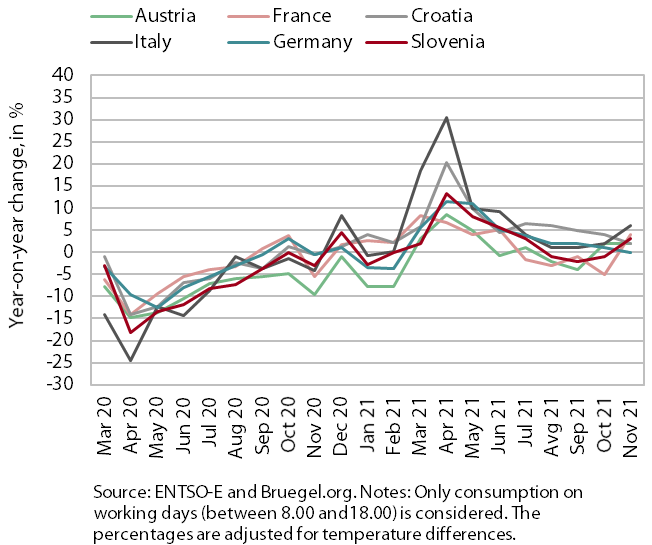
Electricity consumption in November was 3% higher year-on-year but only 1% lower than in the same period of 2019. The year-on-year increase is related to lower consumption at the beginning of the second wave of the epidemic last year, when containment measures were stricter than this year. Compared to November last year, consumption was higher in most of Slovenia's main trading partners - by 2% in Austria and Croatia, 4% in France, 6% in Italy, while it remained about the same in Germany. The largest decrease in consumption among Slovenia's main trading partners compared to November 2019 was recorded in Austria, at 7% (as a result of the lockdown). Compared to November 2019, consumption was also lower in France and Germany (by 3% and 1% respectively), while it was higher in Croatia and Italy (1%).
Turnover based on fiscal verification of invoices, November 2021
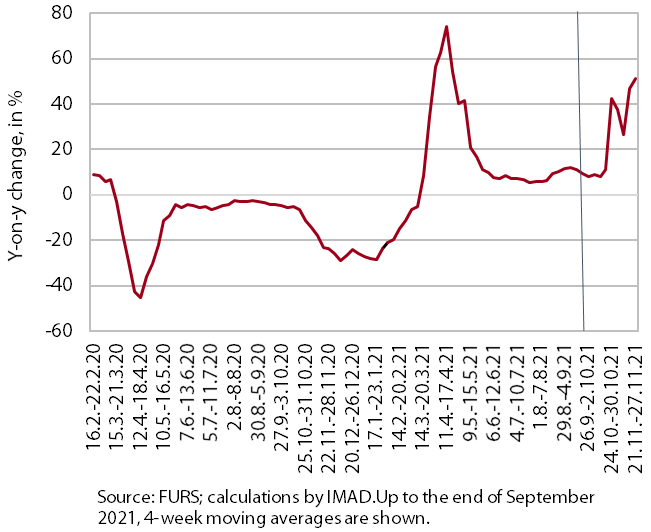
According to data on the fiscal verification of invoices, total turnover between 14 and 27 November was 49% higher year-on-year and 8% higher than in the same period of 2019. Year-on-year growth was higher in most activities compared to the previous two weeks, mainly due to low sales last year caused by the closure of non-essential shops (from 16 November) and the introduction of other tighter containment measures. Turnover growth in trade almost doubled (to 42%) year-on-year, which was also influenced by strong Black Friday sales. Very strong growth was recorded in activities that were almost completely shut down in the same period last year (accommodation and food service activities, travel agency activities and arts, entertainment and recreation). Compared to the same period in 2019, turnover was lower in all activities except in trade. Growth in trade was also impacted by high Black Friday sales this year, which was not included in the same period in 2019 (when Black Friday was held on 29 November).
Turnover in trade, September 2021
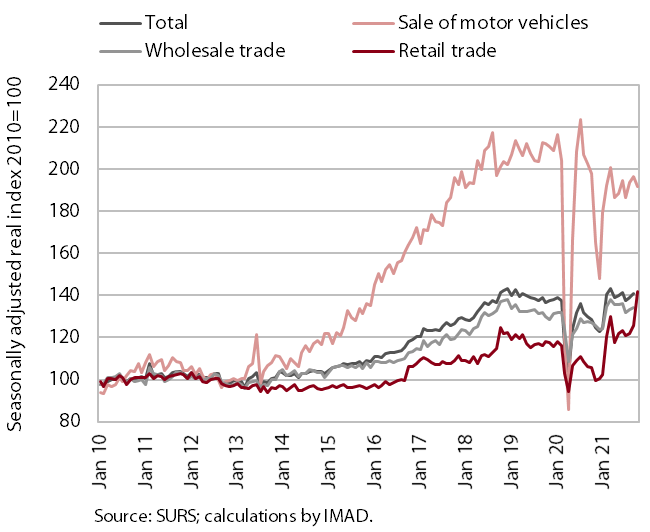
Turnover in trade decreased slightly in the third quarter compared to the second quarter, but was higher year-on-year and compared to 2019. Of the three main trade segments, only wholesale trade recorded lower turnover than in the previous quarter, due to a poorer business performance in July. Turnover in retail trade increased mainly due to higher sale of automotive fuels, influenced by increased transit through Slovenia, and higher sales to households and legal entities. Quarter-on-quarter, turnover also increased in motor vehicle sales, which was lower year-on-year and was also the only major sector, apart from automotive fuel sales, to lag behind turnover in the third quarter of 2019. Compared to the latter period, sales of non-food products (15%) and food products (7%) was significantly higher. In the non-food group, sales via mail order and the internet rose in particular, almost doubling, and sales of pharmaceutical and medical products, furniture and computer and telecommunications equipment also rose by about a tenth. According to preliminary data, turnover in retail trade rose strongly in October, while turnover in motor vehicle sales decreased.
Turnover in market services, September 2021
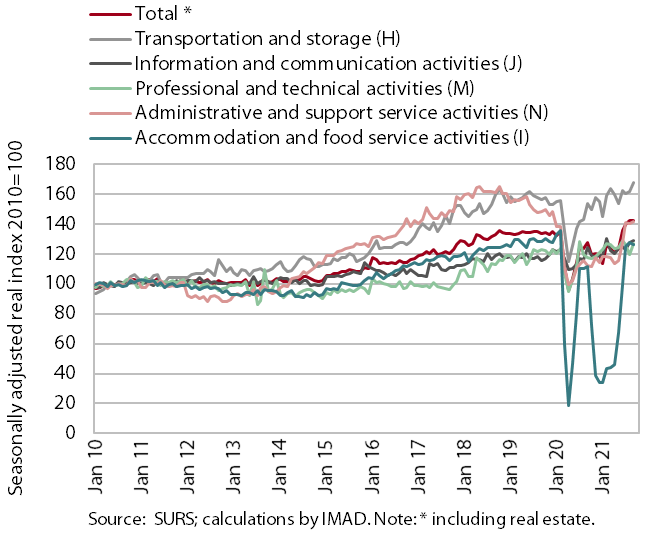
Real turnover increased further in most services in the third quarter. Turnover increased by 11.7% compared with the previous quarter and by 13.3% year-on-year. The highest quarter-on-quarter increase in turnover was recorded in accommodation and food service activities (by 77%), due to an increase in overnight stays by foreign and domestic tourists and a higher number of same-day visitors, also driven by the redemption of last year’s and this year’s vouchers. Turnover, which was 15% higher year-on-year, was only one percent behind that of the same period in 2019. High quarter-on-quarter growth was also recorded in administrative and support service activities (19%), where turnover almost tripled in travel agencies, while it continued to decline in employment agencies. Turnover in transportation continued to grow moderately, mainly due to increases in the storage sector. Turnover in information and communication activities improved again due to higher sales in the domestic and foreign markets for telecommunications and computer services. Lower turnover was recorded only in professional and technical activities, mainly as a consequence of declining turnover in architectural and engineering services. Year-on-year turnover growth was positive across all market services in the third quarter. Compared to the same period in 2019, only travel and employment agencies saw significantly lower turnover (by 47% and by 20% respectively).
